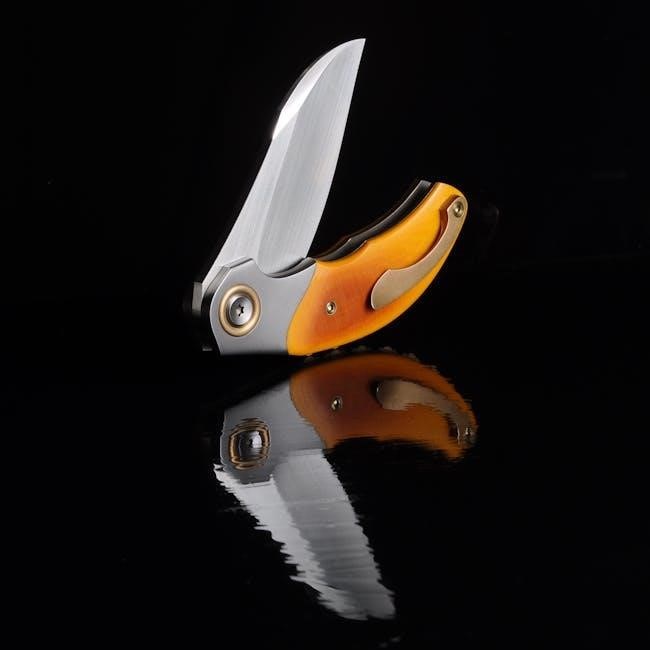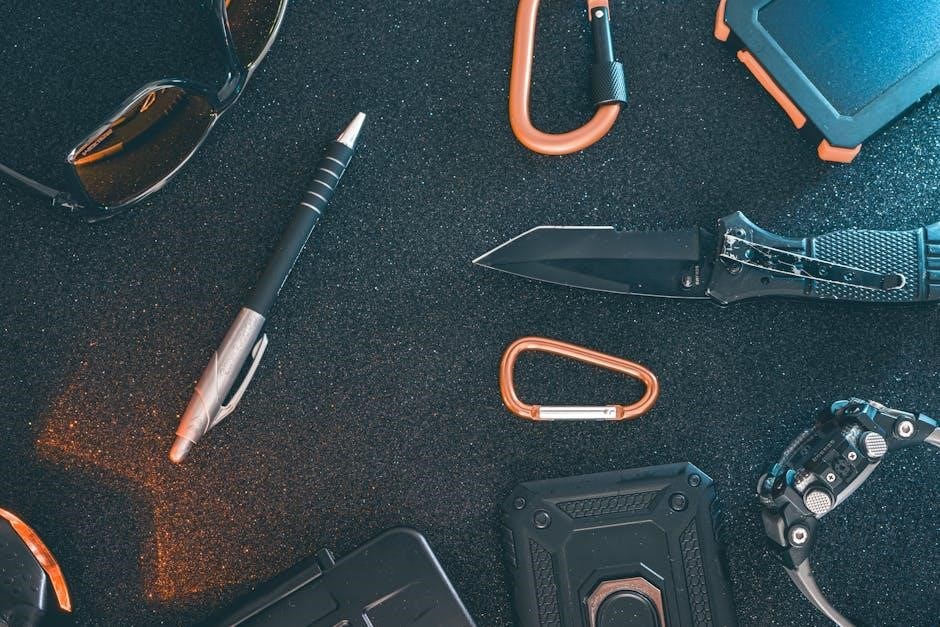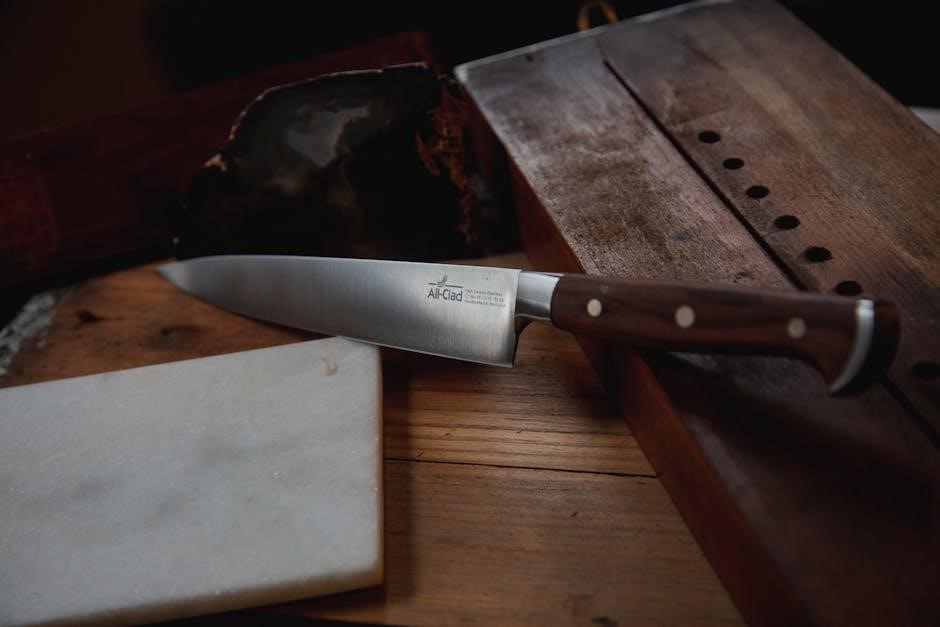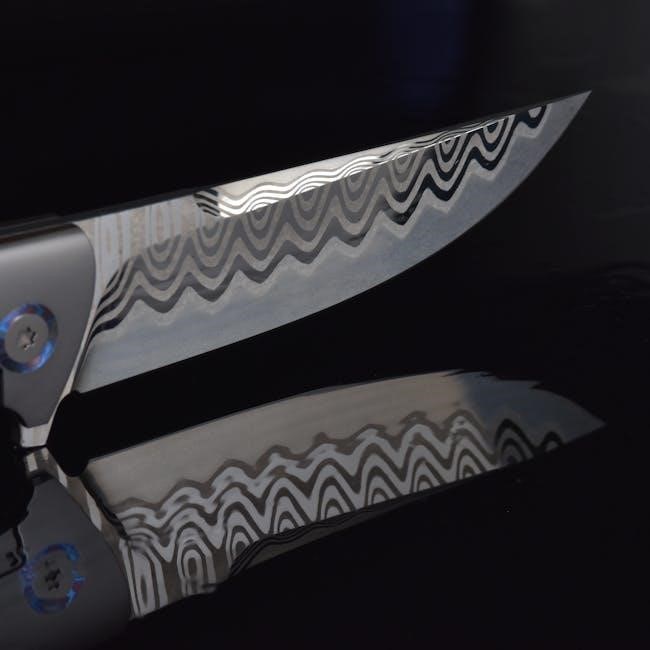A knife steel chart is a visual guide comparing different steel types based on properties like hardness, corrosion resistance, and edge retention, aiding knife selection and understanding for makers and users.
1.1 What is a Knife Steel Chart?
A knife steel chart is a comparative guide that visually represents the properties of various steel types used in knives. It helps users understand differences in hardness, corrosion resistance, edge retention, and toughness, making it easier to select the right steel for specific needs. This tool is invaluable for both knife makers and enthusiasts seeking optimal performance.
1.2 Importance of Understanding Knife Steel
Understanding knife steel is crucial for evaluating a knife’s performance, durability, and suitability for specific tasks. It helps users make informed decisions about which steel type best meets their needs, whether for everyday use or specialized purposes, ensuring optimal results and avoiding common pitfalls in knife selection and maintenance.

Common Types of Knife Steel
Knife steel types include Carbon Steel, Stainless Steel, High-Carbon Stainless Steel (HCS), Tool Steel, and Damascus Steel, each offering unique properties for various applications and preferences.
2.1 Carbon Steel
Carbon steel, known for its high carbon content, offers exceptional hardness and edge retention, making it ideal for sharp, durable blades. It is often used in high-end knives but lacks corrosion resistance. Examples include 1095, a popular choice for its balance of hardness and toughness. Carbon steel requires proper maintenance to prevent rust, making it suitable for experienced users seeking performance over convenience. It is easily identifiable through spark testing, showing straight lines with occasional bursts, and is prized for its ability to hold a sharp edge in demanding applications. Regular sharpening and care are essential to maximize its potential, ensuring longevity and optimal cutting efficiency. Its versatility makes it a favorite among knife enthusiasts and professionals alike, particularly in environments where corrosion is less of a concern. For those willing to invest time in upkeep, carbon steel delivers unmatched results. However, for everyday carry or marine environments, alternative steels may be more practical, as they offer better resistance to corrosion without sacrificing too much edge retention. Despite this, carbon steel remains a cornerstone in knife-making, offering a blend of tradition and performance that continues to appeal to many. Its reputation is built on decades of reliability and adaptability, making it a timeless choice for both functional and collectible knives. Additionally, the heat treatment process plays a crucial role in determining the final properties of carbon steel blades, as improper tempering can lead to brittleness or softness, undermining its potential. As such, carbon steel is not just a material but a testament to the craftsmanship and knowledge of knife makers, who must carefully balance its inherent qualities to produce exceptional tools. Ultimately, carbon steel stands as a testament to the enduring legacy of traditional metallurgy in modern knife-making, offering a unique combination of strength, sharpness, and character that continues to inspire both makers and users alike. While newer, high-tech steels have emerged, carbon steel remains a classic choice, cherished for its raw performance and the connection it provides to the roots of knife craftsmanship. For those who appreciate the simplicity and effectiveness of a well-crafted blade, carbon steel is an excellent option, delivering years of reliable service with proper care. Its appeal lies in its no-frills approach, prioritizing functionality and sharpness above all else, making it a staple in the world of knives for both practical and aesthetic reasons. Whether for utility, sport, or collection, carbon steel knives are a testament to the art of knife-making, blending tradition with innovation to meet the needs of discerning users. In conclusion, carbon steel is a versatile and reliable choice, offering a unique set of benefits that make it a preferred material for many knife enthusiasts and professionals. Its enduring popularity is a reflection of its proven performance and the timeless appeal of a well-made blade. As knife-making evolves, carbon steel remains a foundational material, ensuring that the traditions of the craft are preserved while continuing to meet the demands of modern users; With its rich history, proven capabilities, and the dedication of skilled craftsmen, carbon steel will undoubtedly remain a cornerstone in the world of knives for years to come.
2.2 Stainless Steel
Stainless steel is renowned for its exceptional corrosion resistance, making it ideal for everyday carry and marine environments. It contains chromium, which forms a protective layer against rust. While it may not hold an edge as well as carbon steel, its durability and low maintenance make it a practical choice. Popular grades like 420J1/J2 and 420HC strike a balance between corrosion resistance and edge retention, offering reliable performance for various applications. Its versatility and ease of care have made stainless steel a favorite for both beginners and professionals seeking a durable, low-fuss option. However, compared to high-carbon steels, it may lack in sharpness and wear resistance, but its ability to withstand harsh conditions makes it a valuable choice for many users. Stainless steel is a testament to modern metallurgy, blending functionality and practicality for everyday use.
2.3 High-Carbon Stainless Steel (HCS)
High-Carbon Stainless Steel (HCS) combines the corrosion resistance of stainless steel with the hardness and edge retention of carbon steel. This alloy contains higher carbon levels, enhancing its ability to hold a sharp edge and resist wear. Grades like 154CM and 420HC exemplify HCS, offering a balance between durability and performance. Its strength lies in its versatility, making it suitable for both everyday use and demanding tasks. However, achieving this balance requires precise heat treatment, as improper processing can lead to brittleness. Despite this, HCS remains a popular choice among knife enthusiasts and professionals who seek a blade that is both resilient and sharp. Its unique composition ensures it performs well in various environments, from corrosion-prone settings to high-wear applications, making it a reliable option for those who value both form and function.
2.4 Tool Steel
Tool Steel is renowned for its exceptional hardness and wear resistance, making it ideal for high-stress applications. Grades like D2 and A2 are commonly used in knives, offering superior edge retention and durability. However, tool steel’s hardness can make it brittle and challenging to sharpen. Proper heat treatment is crucial to balance its properties, ensuring optimal performance without compromising toughness. Its high alloy content enhances resistance to deformation, making it a favorite for professional-grade tools and premium knives. Despite being more difficult to work with, tool steel’s unmatched durability and performance justify its use in high-end knife making. Its ability to withstand harsh conditions and maintain edge integrity over time makes it a preferred choice for those seeking a long-lasting, reliable blade.
2.5 Damascus Steel
Damascus Steel is renowned for its striking wavy patterns and exceptional strength. Composed of multiple layers, it offers excellent edge retention and corrosion resistance. Its unique aesthetic appeal and durability make it a favorite for both functional knives and collectibles. This steel type balances beauty with performance, making it highly sought after by enthusiasts and craftsmen alike for its blend of artistry and functionality.

Key Properties of Knife Steel
Understanding key properties like hardness, edge retention, corrosion resistance, toughness, and wear resistance is crucial for evaluating steel performance. These factors determine a knife’s durability and suitability for specific tasks, helping users make informed decisions based on their needs and preferences.
3.1 Hardness (HRC)
Hardness, measured in Rockwell Hardness Scale (HRC), indicates a steel’s resistance to deformation and wear. Higher HRC values suggest better edge retention but may increase brittleness. Heat treatment significantly affects hardness, with optimal ranges varying by steel type. Balancing hardness with toughness ensures durability and performance for specific knife applications, making it a critical property to evaluate in knife steel charts.
3.2 Edge Retention
Edge retention refers to how well a knife maintains its sharpness over time. Steels with high hardness and wear resistance, like S30V or 154CM, excel in this category. Proper heat treatment and blade geometry enhance edge retention, making it a key factor in knife performance for both everyday use and specialized tasks, as highlighted in knife steel charts.
3.3 Corrosion Resistance
Corrosion resistance is a steel’s ability to withstand rust and degradation, crucial for knives exposed to moisture. Stainless steels, such as 420J2 and 420HC, have high chromium content, enhancing this property. Knife steel charts often rate corrosion resistance, helping users choose durable blades for environments like marine or culinary settings, ensuring longevity and performance without frequent maintenance or protection.
3.4 Toughness
Toughness refers to a steel’s ability to absorb impact without breaking, crucial for knives used in demanding tasks. High-carbon steels like 1095 offer excellent toughness but may lack corrosion resistance. Stainless steels, such as 420HC, balance toughness with corrosion resistance, making them ideal for harsh environments. Knife steel charts highlight toughness ratings, ensuring users select blades that withstand heavy use without fracturing or deforming prematurely.
3.5 Wear Resistance
Wear resistance measures how well a steel withstands abrasive forces, preventing dulling. High-carbon steels like D2 and A2 excel in wear resistance, maintaining sharpness longer. Stainless steels, such as S30V, balance wear resistance with corrosion resistance, making them durable in various conditions. Knife steel charts often rank wear resistance, helping users choose blades that remain sharp and resilient over time, reducing maintenance needs significantly.
How to Read a Knife Steel Chart
A knife steel chart organizes data on steel properties like hardness, corrosion resistance, and edge retention, enabling users to compare and select the best steel for their needs effectively.
4.1 Understanding the Ratings
Knife steel charts use ratings to compare properties like hardness, edge retention, and corrosion resistance. These ratings are often numerical, with higher values indicating better performance. For example, a steel with an HRC (Rockwell Hardness) of 60 is harder than one with HRC 55. Understanding these ratings helps in selecting the right steel for specific knife uses, ensuring optimal performance based on the intended application.
4.2 Interpreting the Data
Interpreting knife steel chart data involves analyzing trade-offs between hardness, edge retention, corrosion resistance, and toughness. Higher hardness often means better edge retention but may sacrifice toughness. Stainless steels excel in corrosion resistance but may lack edge retention compared to carbon steels. Understanding these trade-offs helps users select the best steel for their specific needs, ensuring optimal performance in various applications.

Popular Knife Steel Grades
Knife steel charts highlight grades like 420HC, 154CM, and S30V, each balancing hardness, corrosion resistance, and edge retention. These steels are widely used in premium knives for durability and performance.
5.1 420J1/J2
420J1 and 420J2 are entry-level stainless steels known for their corrosion resistance and affordability. They contain 13% chromium, making them suitable for basic use. While they lack high hardness and edge retention, they are easy to sharpen and maintain, making them ideal for everyday carry knives and budget-friendly options.
5.2 420HC
420HC is a higher-carbon version of 420 steel, offering improved hardness and edge retention while maintaining corrosion resistance. It is commonly used in mid-range knives, providing a balance between durability and affordability. With proper heat treatment, 420HC can achieve an HRC of 56-59, making it suitable for both everyday use and light-duty applications.
5.3 1095
1095 is a high-carbon steel known for its hardness, edge retention, and ease of sharpening. With a carbon content of 0.95%, it offers excellent wear resistance but is more prone to corrosion. Often used in high-performance knives, it excels in applications requiring sharpness and durability, though it demands proper maintenance to prevent rust.
5.4 154CM
154CM is a high-carbon stainless steel with exceptional hardness and edge retention, ideal for high-end knives. Its balanced composition offers corrosion resistance and durability, making it suitable for both everyday use and demanding tasks. This steel is prized for its versatility, combining the benefits of stainless and carbon steels in a single, high-performance material.
5.5 S30V
S30V is a premium steel known for its high carbon and vanadium content, offering exceptional hardness and edge retention. It excels in wear resistance and corrosion resistance, making it ideal for high-end knives. While challenging to sharpen, its performance in demanding tasks is unmatched, making it a favorite among knife enthusiasts and professionals alike.
Steel Hardening and Heat Treatment
Steel hardening and heat treatment are critical processes that enhance knife steel properties. Quenching and tempering are key steps to achieve desired hardness, toughness, and durability.
6.1 The Role of Heat Treatment
Heat treatment is crucial for optimizing knife steel properties. It involves processes like annealing, normalizing, quenching, and tempering to achieve the desired microstructure, enhancing hardness, toughness, and wear resistance. Proper heat treatment ensures the steel meets performance requirements for specific applications, making it a cornerstone in knife manufacturing. Consistent techniques yield reliable results.
6.2 Quenching and Tempering
Quenching and tempering are critical steps in heat treatment. Quenching rapidly cools steel to achieve maximum hardness, while tempering stabilizes the microstructure, reducing brittleness and enhancing toughness. This process balances hardness and flexibility, ensuring the blade is durable and resistant to wear. Proper quenching and tempering techniques are essential for achieving optimal steel performance in knife applications.

Choosing the Right Steel for Your Knife
Selecting the right steel involves considering the knife’s intended use, environmental exposure, and desired properties. Balancing hardness, corrosion resistance, and toughness ensures optimal performance for specific tasks.
7.1 Considerations for Different Uses
Choosing steel depends on the knife’s purpose. Hunting knives need high hardness and edge retention, while culinary knives prioritize corrosion resistance. Everyday carry knives balance toughness and wear resistance. Heat treatment and quenching processes further tailor steel properties to specific applications, ensuring optimal performance for intended tasks and environmental conditions.
7.2 Balancing Properties
Knife steel properties often involve trade-offs. High hardness may compromise toughness, while extreme corrosion resistance might reduce edge retention. Balancing these traits is crucial for optimal performance, ensuring the knife meets its intended use without sacrificing durability or functionality. Heat treatment and alloy composition play key roles in achieving this balance, tailoring the steel to specific demands and applications.
